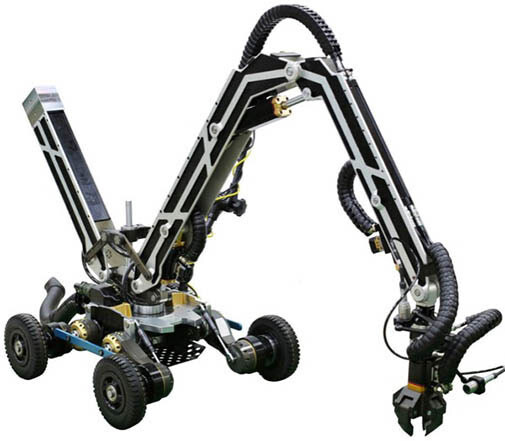
Seoul, South Korea – As the global nuclear power industry grapples with an aging fleet of reactors, a new frontier in high-tech robotics is emerging to tackle the perilous task of decommissioning. South Korean hydraulic robotics specialist, KNR System, is at the forefront of this monumental shift, positioning its advanced robotic solutions to replace human intervention in the highly hazardous environment of nuclear power plant dismantlement.
The company's foray into this critical sector comes as the worldwide nuclear decommissioning market is projected to reach an estimated 500 trillion Korean Won (approximately $360 billion USD), driven by the permanent shutdown of reactors that have reached or exceeded their operational lifespans. Industry forecasts suggest that nearly half of the world's 423 operational nuclear reactors, with around 198 units, are expected to enter the decommissioning phase by 2050. This surge necessitates robust, safe, and efficient methods for dismantling facilities contaminated with radiation and other hazardous materials.
KNR System: A Pioneer in Hydraulic Robotics
Established in Hwaseong, Gyeonggi Province, in 2000, KNR System has built its expertise on precision control technology for hydraulic and electric systems. The company specializes in developing core hydraulic components such as linear and rotary actuators, mobile hydraulic power units, and servo valves, along with integrated control software. This foundational technology has enabled KNR System to offer total solutions, from fundamental research and development to robot manufacturing and operational control. Its technological prowess was recognized last year with a technical exception listing on the KOSDAQ market.
At the core of KNR System’s nuclear decommissioning strategy is its "robot special force," designed to ensure safety as the paramount priority in high-risk environments. "When demand like nuclear decommissioning begins to arise, a related market forms," stated Kim Myeong-han, CEO of KNR System, in a recent interview. "Based on long-term preparation, including the accumulation of original technologies and know-how, our motto is to replace humans with hydraulic robots suitable for high-risk work, thereby securing safety above all else."
Hydra-DC: The Decommissioning Vanguard
KNR System’s flagship nuclear decommissioning robot arm, "Hydra-DC," developed in 2019, epitomizes this commitment to safety and efficiency. Constructed from radiation-resistant materials, the Hydra-DC is engineered for prolonged operation in highly radioactive environments. It is equipped with plasma and laser cutting capabilities, enabling precise dismantling and removal of internal reactor structures.
A standout feature of the Hydra-DC is its robust waterproof and pressure-resistant design, capable of withstanding water pressure at depths of up to 20 meters. This allows for seamless operation in submerged, radioactive facilities within nuclear plants, where human access is impossible. The robot arm has already undergone successful demonstration tests in simulated nuclear reactor environments, proving its capability to perform critical cutting and removal tasks. The company’s broader "HYDRA" series, including the HYDRA-MP (Manipulator) and HYDRA-UW (Underwater), further underscores its mastery of high-payload, high-precision hydraulic manipulators for extreme conditions, capable of heavy-load lifts and deep underwater operations.
Further bolstering its credentials, KNR System recently secured an explosion-proof certification from the Korea Gas Safety Corporation. This critical certification signifies the robot’s resilience against explosion risks posed by both radiation and dust, meeting stringent safety standards required internationally for operation in flammable and explosive atmospheres. "Nuclear decommissioning is a task where high radiation and dust explosion risks coexist, making the durability and safety of robots paramount," CEO Kim emphasized, likening the certification to providing the robot with its "final armor."
Real-World Application: Kori 1 and Wolseong 1
KNR System is actively collaborating with Korea Hydro & Nuclear Power (KHNP) to demonstrate its robot systems in actual nuclear decommissioning environments. Since 2018, the company has been involved in validating its decommissioning robots in KHNP's simulated environments. Currently, KNR System is deploying its "Heavy Water Reactor Fuel Rod Retrieval Robot," designed to withstand up to 100,000 rads of radiation intensity, at the Wolseong Unit 1 nuclear power plant. This initiative is crucial as South Korea prepares for the decommissioning of its first heavy water reactor.
The recent official approval by the Nuclear Safety and Security Commission on June 26, 2025, for the decommissioning of Kori Unit 1 – Korea's inaugural nuclear power plant – marks a pivotal moment. After 47 years of commercial operation and 8 years since its permanent shutdown in 2017, the 1.07 trillion Korean Won project is slated for completion by 2037. The decommissioning process, which is expected to take at least 12 years for active dismantling, will involve a meticulous multi-stage approach, including initial decontamination, transfer of spent nuclear fuel to on-site dry storage by 2031, removal of radioactive systems, and eventual site restoration. KNR System's involvement in this historic project is anticipated to provide invaluable experience and a robust track record.
Global Ambitions and Future Horizons
The challenges of nuclear decommissioning are multifaceted, encompassing immense costs, complex regulatory frameworks, managing radioactive waste, and unforeseen complications. However, the burgeoning market also represents significant opportunities for innovation. KNR System aims to capitalize on this trend by not only expanding its presence in domestic and international nuclear decommissioning markets but also by applying its technology to other high-risk, heavy-duty sectors. The company plans to extend its integrated solutions to tasks involving large, heavy objects in environments such as offshore structures, large vessels, steel plants, and chemical facilities.
"Our robot technology is the only integrated solution in Korea that possesses both radiation response capabilities and underwater cutting functions," affirmed Kim Kyung-seok, CEO of KNR System. "By enhancing our technology and on-site application capabilities, we aim to become a leading nuclear decommissioning robot specialist, gaining recognition not only in Korea but also in the global market." KNR System's strategic focus on safety, efficiency, and technological advancement positions it as a key player in the complex, yet essential, future of global nuclear energy management.
[Copyright (c) Global Economic Times. All Rights Reserved.]






























